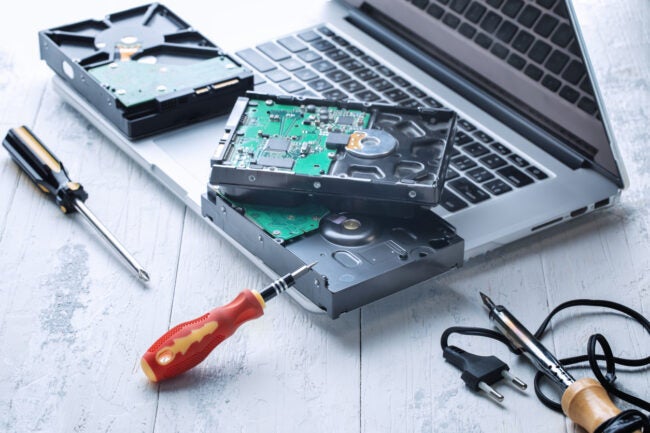Before you recycle your old computer, make sure that identity thieves do not have access to your passwords, credit card numbers, or other personal information.
Our computers are a treasure trove of personal information, including Social Security numbers, credit card numbers, bank account numbers, and website logins and passwords. If you delete this data or reformat your hard drive with a data-erasure program, this information may remain on your hard drive. For this reason, it is important to erase or destroy the hard disk before recycling or donating the computer, but it is not as easy as smashing it with a hammer. Read on to learn how to destroy your hard disk and protect your data.

Before you begin
Do not do this until you have backed up any files (including photos and videos) that you want to keep on your hard disk. Transfer these data to a new computer or external hard drive or upload them to a cloud storage service before destroying the old drive. Failure to do so will result in loss of information and will be unrecoverable.
Step 1: Remove the hard drive from the computer.
Using a precision screwdriver, remove the computer casing and locate the hard disk drive. It should look like a thin rectangular metal case. Once found, remove the hard disk drive from the computer.
The type and number of screws to remove will vary depending on the manufacturer, type and age of the computer. Buy an exact set of screwdrivers, which come in a variety of shapes and sizes, so you can cover your bases.

Step 2: Access the hard disk platters and circuit board.
Once the hard disk is removed from the computer, you will need to open the metal casing to access the platters and circuit board. This next step is important because removing the hard disk from the computer does not delete the data stored on the platters and the drive may still be accessible if the circuit board is not destroyed.
The screws that hold the hard disk casing in place are usually either flat head screws or Torx screws. Using the appropriate screwdriver from a precision screwdriver set, remove these screws and remove the metal casing to expose the internal components of the drive.
Step 3: Remove the read/write arm and use a screwdriver to scrape the platters to destroy the data.
The metal casing of the hard disk protects the internal components and holds the data stored on the platters; removing the casing exposes the platters. The platter is a round disk, like a CD or DVD, that rotates at high speed around a central axis. Data on the hard disk is recorded and read by a read/write arm located above the platter.
To access the platter, use a precision Torx screwdriver to unscrew and remove the read/write arm. Lift the platter from the spindle and remove the top layer of the platter with a screwdriver. If you find it boring to scratch the platter with a screwdriver, you can destroy the platter in many other ways. If the surface of the disc is scratched or burned, you can use sandpaper, a rotary tool, or even fire.

Step 4: Break the circuit board.
Destroying the platters will eliminate the data stored on the drive, but if you want to be extra careful not to access personal information, the next step is to remove the circuit board. The circuit board is responsible for running the hard disk and usually contains chips that control access to ROM, NV-RAM, and the drive. If this circuit board is damaged or removed, the drive cannot be accessed, regardless of the condition of the platters.
To remove the board, use a precision screwdriver to loosen all screws securing the board to the hard disk drive. Lift the board from the drive and break it in half. Be sure to wear eye protection while doing this. This will prevent small pieces of the board from getting into your eyes. You may also consider wearing thin work gloves to protect your hands.

Step 5: Recycle computer parts.
After disassembling or destroying the hard drive, you will need to recycle its parts. The U.S. Environmental Protection Agency lists a number of companies and programs that recycle old, used, or damaged electronics. Local governments may offer electronics recycling programs to reduce waste in their communities.
Electronic waste, including computer hard disk components, can take hundreds of thousands of years to decompose in a landfill. While it may be a hassle to load old computer parts into your car and drive to a recycling center, it is a more environmentally friendly method of disposal than throwing them in the trash.
Destroying the hard disk and erasing stored personal information can protect you from identity theft and possible money fraud. Removing and destroying the platters is the most important step in this process, but you can also take the extra step and destroy the circuit board to prevent any access to the hard disk. Remember to use proper eye protection when breaking the board for safety reasons (also consider wearing thin work gloves to protect your hands).










